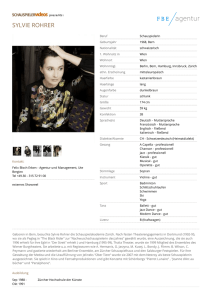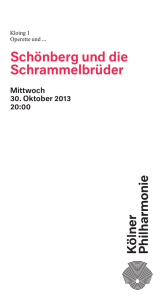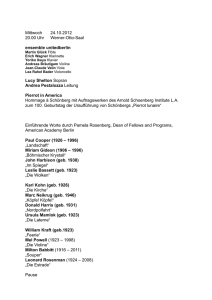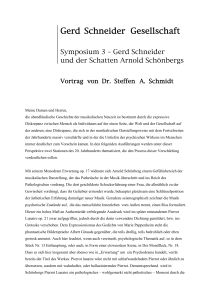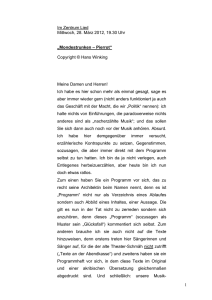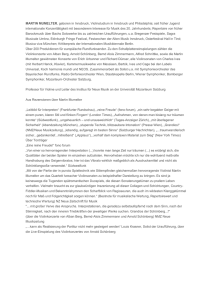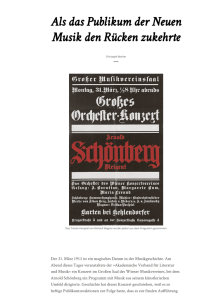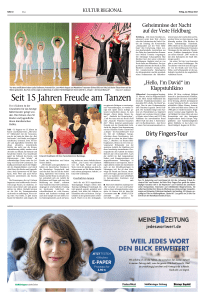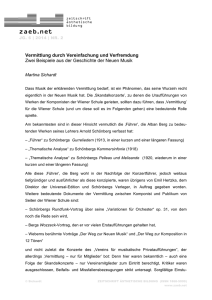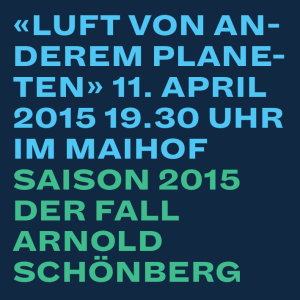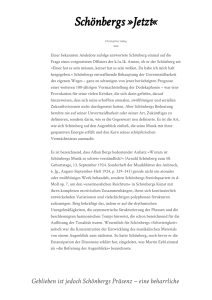Pierrot lunaire.indb - Arnold Schönberg Center
Werbung
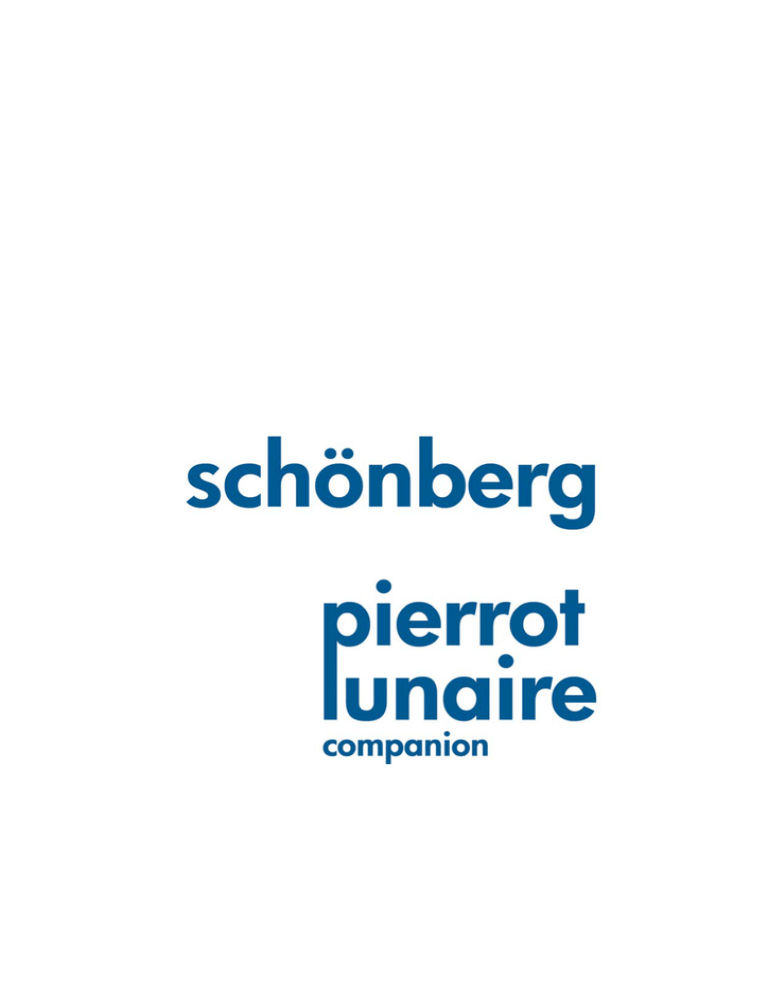
Cover-Abbildung: Pierrot lunaire op. 21, Nacht. Skizze | Sketch © Universal Edition A. G., Wien; Arnold Schönberg, 1924 Diese Publikation erscheint anlässlich der Sonderausstellung »Pierrot lunaire = 100« am Arnold Schönberg Center, Wien 5. Oktober 2012 – 4. Januar 2013 Impressum Medieninhaber: Arnold Schönberg Center Privatstiftung Schwarzenbergplatz 6 A-1030 Wien www.schoenberg.at Texte, Zusammenstellung und Redaktion: Eike Feß | Therese Muxeneder Universal Edition, Wien UE 26 313 ISMN 979-0-008-08505-5 UPC 8-03452-06885-3 ISBN 978-3-7024-7174-3 www.universaledition.com Distributed in North America, Canada and Mexico by Belmont Music Publishers BEL-1090 www.schoenbergmusic.com © Arnold Schönberg Center Privatstiftung, Wien 2012 ISBN 978-3-902012-13-7 Herausgeber und für den Inhalt verantwortlich: Christian Meyer Gestaltungskonzept und Satz: Forte OG, Thomas Stark Cover: Christoph Edtmayr Druck: Grasl Druck & Neue Medien GmbH, Bad Vöslau Inhalt I Contents Seite I Page Vorwort | Preface. . . . . . . . . . . . . . . . . . . . . 5 Preface to the score of Pierrot lunaire Vorwort zur Partitur des Pierrot lunaire . . . . . . . . . . . . 6 Pierrot lunaire | Dramatis personae | Synopsis . . . . . . . . . 10 Uneingeschränkte Tonfreiheit! Unrestricted freedom of tone! . . . . . . . . . . . . . . . . 20 Pierrot lunaire ist nicht zu singen! Pierrot lunaire should not be sung! . . . . . . . . . . . . . . 28 Ich gehe unbedingt … einem neuen Ausdruck entgegen I am definitely approaching … a new form of expression . . . . . 36 Nacht – eine Kontrapunktstudie Night – a study on counterpoint . . . . . . . . . . . . . . . 46 Pierrot aufführen Performing Pierrot . . . . . . . . . . . . . . . . . . . . 54 Arnold Schönberg: Begleittext zur Schallplatte Arnold Schönberg: Recording notes . . . . . . . . . . . . . 62 Gravitationszentrum Pierrot Gravitational center Pierrot . . . . . . . . . . . . . . . . . 66 Conrad Felixmüller: Pierrot lunaire, 1913 . . . . . . . . . . . . 70 Pierrot lunaire Ensemble, Berlin 1912 (v. l. n. r.: Karl Essberger, Emil Telmányi, Arnold Schönberg, Albertine Zehme, Eduard Steuermann, Hans Kindler, Hans W. de Vries) 5 Vorwort | Preface Vorwort | Preface Arnold Schönbergs Pierrot lunaire, ein Schlüsselwerk der musikalischen Moderne, entstand 1912 in Berlin im Auftrag von Albertine Zehme. Die Vortragskünstlerin verfolgte mit ihren Rezitationen eine höchst individuelle Ästhetik, darin sie „dem Ohr seine Stellung fürs Leben zurückerobern“ wollte. Pierrot lunaire ist zur Zeit seiner Entstehung ein gattungshistorischer Solitär und markiert einen Höhepunkt in Arnold Schönbergs expressionistischer Kompositionsperiode: der berühmte Melodramenzyklus ist in der extremen Gefahrenzone nachromantischen Komponierens angesiedelt. Pierrot »mit wächsernem Antlitz«, eine bizarre und nervöse Gestalt, verlockt in eine Gegenwelt nächtlicher Phantasmen und auswegloser Passionen. Ein Kosmos klanglicher Schattierungen im farbigen Zwischenreich von Singen und Sprechen. Uneingeschränkte Tonfreiheit! Arnold Schönberg composed Pierrot lunaire, one of the benchmarks of modern music, in Berlin in 1912. The work was commissioned by Albertine Zehme, whose recitations were marked by a highly individual aesthetic, aiming to “recapture the ear’s prerogative in life”. In terms of its genre, Pierrot lunaire was historically unique at the time Schönberg composed it and marks the high point of his expressionistic period: He placed the famous melodrama is placed in the extreme danger zone of post-Romantic composition. Pierrot, “with waxen countenance”, is a bizarre and nervous figure, enticed into a counterworld of nighttime phantasms and hopeless passions. A cosmos of tonal shading in the colorful realm between singing and speaking. Unrestricted freedom of tone! Eike Feß | Therese Muxeneder 6 Pierrot lunaire Preface to the score of Pierrot lunaire The melody given in the Sprechstimme by means of notes is not, except for isolated exceptions that are specially marked, intended for singing. The task of the performer is to transform it into a speech-melody, taking into account the given pitch. This is achieved by: I. Keeping very closely to the rhythm as if you were singing, i.e. with no more freedom than would be allowed with a singing melody; II. Becoming aware of the difference between singing tone and speaking tone: the singing tone unalterably stays on the pitch; whereas the speaking tone gives the pitch but immediately leaves it again by falling or rising. However the performer has to be very careful not to adopt a singsong way of speaking. That is not intended at all. In no way should one strive for realistic, natural speech. Quite on the contrary, the difference between ordinary speaking and the kind of speaking involved in a musical form should become obvious. But at the same time it must never be reminiscent of singing. Incidentally, I would like to make the following comment on the performance: It is never the task of the performers to recreate the mood and character of the individual pieces on the basis of the meaning of words, but solely on the basis of the music. To the extent that the tone-painting-like rendering of the events and feelings given in the text was important to the author, it is found in the music anyway. Where the performer finds it is lacking, he should abstain from presenting something that was not intended by the author. Otherwise he would be detracting rather than adding. Arnold Schönberg Universal Edition, Wien 1914 Preface to the score 7 Villa Lepcke, Berlin-Zehlendorf Geburtshaus des Pierrot lunaire Birthplace of Pierrot lunaire Arnold Schönberg, 1912 Foto: Hugo Erfurth 10 Pierrot lunaire Pierrot lunaire | Dramatis personae | Synopsis Arnold Schönberg (1874, Wien – 1951, Los Angeles) → Komponist, Schriftsteller, Maler, Lehrer, Theoretiker, Erfinder, Leitfigur der Wiener Schule, Vordenker der Zwölftonmethode, Elementarereignis der neueren Musikgeschichte Pierrot lunaire op. 21 (1912, Berlin) → Melodramenzyklus in drei Teilen (zu je sieben Gedichten) für eine Sprechstimme, Klavier, Flöte (auch Piccolo), Klarinette (auch Bassklarinette), Geige (auch Bratsche) und Violoncello; Spiellänge mit (zwei Satzpausen): ca. 35 (45) Minuten; Gründungsdokument der musikalischen Moderne; auch bekannt als »Nervenzentrum der Musik des frühen 20. Jahrhunderts« (Igor Strawinsky) Pierrot (17. Jahrhundert, Bergamo) → Bühnenfigur der Commedia dell’arte; interkultureller Multimediastar in bildender Kunst, Literatur, Musik und Film; Popularitätshöhepunkt im 19. Jahrhundert; Exzentriker, Melancholiker mit Hang zum Mondlicht, Symbolgestalt für Exaltationen aller Arten Albert Giraud (1860, Leuven – 1929, Brüssel) → (geb. Emile Albert Kayenburgh) Lyriker, Journalist, Verfasser der symbolistischen Gedichtsammlung Pierrot lunaire: Rondels bergamasques (1884) im Kontext der belgisch-französischen Fin-de-Siècle-Literatur Otto Erich Hartleben (1864, Clausthal – 1905, Salò) → Schriftsteller, Jurist, zusammen mit Rudolf Steiner Herausgeber einer Literaturzeitschrift, 1892/93 Publikation seiner freien Übertragungen der 50 Gedichte aus Albert Girauds Pierrot lunaire ins Deutsche Albertine Zehme (1857, Wien – 1946, Naumburg) → Schauspielerin, Sängerin, Vortragskünstlerin, Stimmbildnerin, Autorin; Auftraggeberin und Widmungsträgerin des Pierrot lunaire von Arnold Schönberg, Interpretin der Berliner Uraufführung im Oktober 1912 und der darauf folgenden Europa-Tournee Felix Zehme (1849–1924, Leipzig) → Anwalt (u. a. von Max Reger), Ehemann von Albertine Zehme, Liebhaber der Künste, Financier des Pierrot lunaire von Arnold Schönberg Eduard Steuermann (1892, Sambor – 1964, New York) → Pianist, Komponist, Schüler von Ferruccio Busoni und Arnold Schönberg, Interpret sämtlicher Klavierwerke Schönbergs und der Berliner Uraufführung des Pierrot lunaire (hier auch Coach von Albertine Zehme) Dramatis personae | Synopsis 11 Marya Freund (1876, Breslau – 1966, Berlin) → Mezzosopranistin, Lehrerin, Sängerin der Uraufführung von Schönbergs Lied der Waldtaube, Interpretin einer ins Französische rückübersetzten PierrotFassung unter Leitung von Darius Milhaud sowie Arnold Schönberg (1920er Jahre) Erika Stiedry-Wagner (1890, Wien – 1974, Zürich) → Schauspielerin, Sängerin, Pierrot-Interpretin zahlreicher von Schönberg geleiteter Aufführungen in den 1920er Jahren sowie der Schallplatteneinspielung von 1940 in New York unter dem Dirigat des Komponisten Die Textarchitektur der Melodramen – ein Genre im »farbigen Zwischenreich von Singen und Sprechen« – ist auf eine »allegorische Parabel über Künstler und Künstlertum « (Reinhold Brinkmann) gerichtet. Pierrot »mit wächsernem Antlitz«, eine bizarre und nervöse Gestalt, verlockt in eine artistische Gegenwelt voll auswegloser Passionen, denen schmerzvoll zu erliegen er selbst auserkoren ist. Der androgyne Pierrot vereinigt als neurotischer Narziss seelische Kontraste in sich. Er gibt sich als Leidender und Sadist, an dessen schwarzem Rock das Stigma des Mondflecks als Zeichen vom Anderssein haftet. Im I. Teil der in Schönbergs Opus 21 vereinigten 3 × 7 Gedichte dominiert die Thematik des Künstlers, dessen Gedankenwelt und Schaffensimpulse durch den Mond symbolisiert werden. Der II. Teil senkt sich nach einer »todeskranken« Eintrübung des Mondlichts tief und tiefer in das Schattenreich des Todes hinab. In dem an parodistischen Elementen reichen III. Teil wird die verschollene Heimatwelt beschworen. »Trotzdem sie alle grotesk sind, so kann man die drei Theile (nach einigen überwiegenden Nuancen) immerhin mit lyrisch, tragisch und humoristisch überschreiben.« (Ferruccio Busoni, 1913) Die Interpretation der irrealen Pierrot-Figur entzieht sich einer gängigen Verstehensroutine und bleibt weitgehend Aufgabe unserer Phantasie. Im Programmheft der Uraufführung stellte Schönberg den Gedichten ein (textlich leicht modifiziertes) Fragment über absolute Poesie des deutschen Dichters Novalis voran: Es lassen sich Erzählungen ohne Zusammenhang, jedoch mit Assoziation, wie Traum, denken – Gedichte, die bloß wohlklingend und voll schöner Worte sind, aber auch ohne allen Sinn und Zusammenhang, höchstens einige Strophen verständlich, wie Bruchstücke aus den verschiedenartigsten Dingen. Diese wahre Poesie kann höchstens einen allegorischen Sinn im Großen und eine indirekte Wirkung haben. Villa Albertine Gautzsch-Leipzig Albertine Zehme, 1912 14 Pierrot lunaire Pierrot lunaire | Dramatis personae | Synopsis Arnold Schönberg (1874, Vienna – 1951, Los Angeles) → Composer, writer, painter, teacher, theoretician, inventor, leading figure of the Viennese School, pioneer of the twelve-tone method, elementary event in music history Pierrot lunaire, op. 21 (1912, Berlin) → Melodrama cycle in three parts (each with seven poems) for Sprechstimme (speaking voice), piano, flute (also piccolo), clarinet (also bass clarinet), violin (also viola) and violoncello; duration (with two breaks between sections): approx. 35 (45) minutes; founding document of musical modernism, also known as the “solar plexus of early 20th-century music” (Igor Stravinsky) Pierrot (17th century, Bergamo) → Theatre figure in the commedia dell’arte; intercultural multimedia star in fine arts, literature, music and film; reached the height of popularity in the 19th century; eccentric, melancholic, with a penchant for moonlight, a symbolic figure for all kinds of exaltations Albert Giraud (1860, Leuven – 1929, Brussels) → (born Emile Albert Kayenburgh) Poet, journalist, author of the collection of symbolist poems Pierrot lunaire: Rondels bergamasques (1884) in the context of Belgian-French fin-de-siècle literature Otto Erich Hartleben (1864, Clausthal – 1905, Salò) → Writer, lawyer, coeditor of a literary journal together with Rudolf Steiner, 1892/93 publication of his free translation into German of the fifty poems from Albert Giraud’s Pierrot lunaire Albertine Zehme (1857, Vienna – 1946, Naumburg) → Actress, singer, reciter, voice trainer, author; commissioned Pierrot lunaire by Arnold Schönberg – the work is dedicated to her; performed the Berlin premiere in October 1912 and on the subsequent tour across Europe Felix Zehme (1849–1924, Leipzig) → Lawyer (represented Max Reger, among others), husband of Albertine Zehme, arts enthusiast, financed Pierrot lunaire by Arnold Schönberg Eduard Steuermann (1892, Sambor – 1964, New York) → Pianist, composer, studied with Ferruccio Busoni and Arnold Schönberg, performed Schönberg’s complete piano works and the premiere of Pierrot lunaire in Berlin (coached Albertine Zehme for this work) Marya Freund (1876, Breslau – 1966, Berlin) → Mezzo-soprano, teacher, sang the premiere of Schönberg’s Lied der Waldtaube, reciter in a Dramatis personae | Synopsis 15 version of Pierrot translated back into French, conducted by Darius Milhaud as well as Arnold Schönberg (1920s) Erika Stiedry-Wagner (1890, Vienna – 1974, Zurich) → Actress, singer, Pierrot reciter at a number of performances conducted by Schönberg in the 1920s and also in 1940 for the first recording in New York, conducted by the composer The architecture of the text in melodramas – a genre in the “colorful realm between singing and speaking” – is aimed at an “allegorical parable about artists and artistry” (Reinhold Brinkmann). Pierrot, “with waxen countenance”, is a bizarre and nervous figure, enticed into an artistic counterworld full of hopeless passions to which he is predestined to painfully succumb. Pierrot is androgynous and as a neurotic Narcissus he unites spiritual contrasts within him. He acts the part of a sufferer and sadist, with the stigma of the Mondfleck [moon’s reflection] on his black cloak as a sign of differentness. The first part of the 3 × 7 poems in Schönberg’s Opus 21 is dominated by the theme of the artist whose intellectual world and creative impulse are symbolized by the moon. After the “death-awaiting” darkening of the moonlight, the second part descends deeper and deeper into death’s shadowy kingdom. The third part, rich in parodistic elements, is an evocation of the lost homeland. “Even though they are all grotesque, the three parts (according to several prevailing nuances) can at least be titled lyric, tragic and humoristic.” (Ferruccio Busoni, 1913) The interpretation of the unreal Pierrot character eludes a routinized understanding and is left largely to our imagination. In the program of the premiere, Schönberg inserted Fragment über absolute Poesie by the German poet Novalis – with a slightly modified text – before the poems: Narrative can be conceived without connections, but with associations, like a dream – poems that merely sound harmonious and are full of beautiful words, but are also without any sense or connection, at most with a few comprehensible strophes, like fragments of the most diversified things. This true poesy can at most have an allegorical meaning on a large scale and an indirect effect. Vertrag zwischen Arnold Schönberg und Albertine Zehme, 10. März 1912 Contract concluded between Arnold Schönberg and Albertine Zehme, March 10, 1912 I. Mr Arnold Schönberg shall compose for Mrs Albertine Zehme from the cycle of poems “Pierrot lunaire” by A. Giraud, translated by Otto Erich Hartleben at least twenty poems as a melodrama with piano accompaniment, possibly accompanied by two other instruments, and is obliged to complete these prior to the beginning of the 1912/1913 season. II. Mr Arnold Schönberg shall award Mrs Albertine Zehme the sole right to perform these compositions in all countries until April 30, 1915. […] IV. Mrs Albertine Zehme is obliged to publicly perform the aforementioned compositions on at least thirty evenings within the period granted to her, and other works may not be included in the program on these evenings. (➔) Albert Giraud / Otto Erich Hartleben: Pierrot lunaire Arnold Schönbergs Kompositionsvorlage Arnold Schönberg’s copy for the composition
